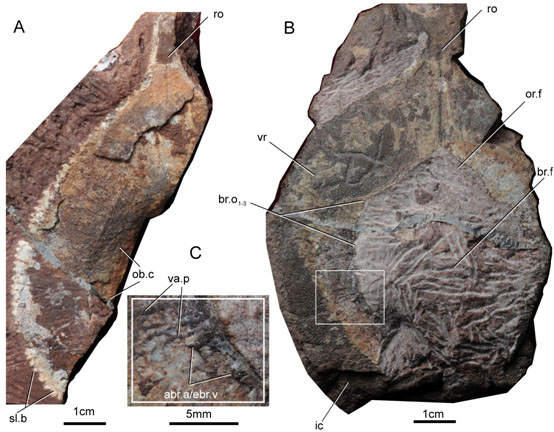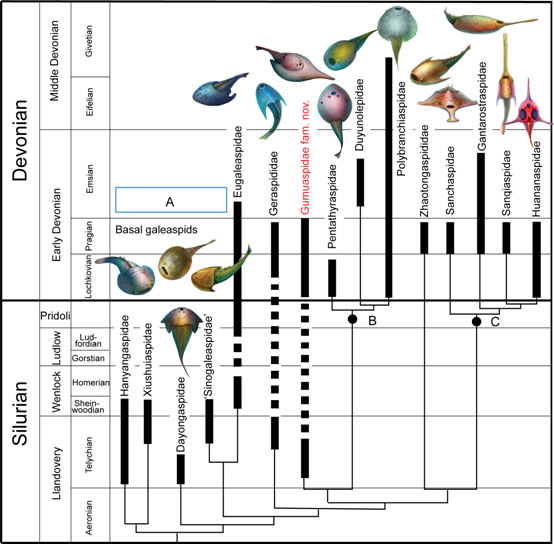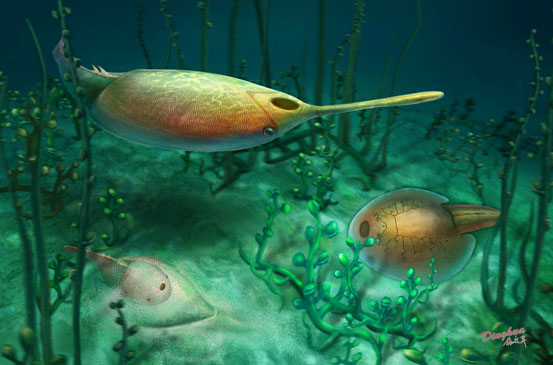Recently, PLoS ONE reported online that Platylomaspis serratus gen. et sp. nov., the earliest multi-branched fish discovered in the Silurian System of the Tarim Basin in Xinjiang, China, will The origin of multibranched fishes advanced from the Early Devonian to the Silurian Landoverian, about 20 million years ago. At the same time, the paleogeographic distribution of multibranched fishes has been extended from the original South China Plate to the Tarim Plate, proving that the two plates were very close to each other in the early Silurian Period, which has very important paleogeographic significance.
The new genus and species are Nanningaspis zengi gen. et sp. nov., which was newly discovered in the Devonian system of Nanning, Guangxi. It has a wide abdominal ring on the edge of the head carapace, and the front edge is elongated into a rostrum. The main identification characteristics and phylogenetic analysis show that they are closely related to the Gumuaspis from the Early Devonian of Yunnan, and together they form a new family of multibranch fishes - Gumuaspidae fam.nov., representing The most primitive group of multibranch fishes.
Chinese armored fishes have long been considered to be a type of bottom-dwelling fish living in near-shore coastal environments. However, a series of new discoveries of armored fishes in recent years indicate that the lifestyle of armored fishes may be greater than originally thought. It is much more complicated. For example, the South China fish-eye snap-shell turtle (Rhegmaspis) discovered in the Posongchong Formation of the Early Devonian Bragg Period in Zhaotong, Yunnan in 2015 has a torpedo-shaped head carapace, a slender rostrum, and an orbital hole located on the ventral side of the head carapace. It is the first armored fish with a streamlined body discovered in China, and a series of specialized features such as the loss of abdominal rings, indicating that some armored fish may have started an active swimming lifestyle and have a more active swimming style. Feeding behavior, and the newly discovered A. serrata and Nanningi fish exhibit many characteristics that have evolved in parallel with modern rays, and may very well represent a new lifestyle of armored fishes - a semi-buried lifestyle. . The new lifestyle allows armored fishes to better hide themselves and avoid predators. Perhaps thanks to this new lifestyle, the family Archeopterygidae has become the longest surviving branch of the armored fish subclass. New research shows that by the Lage Period of the Early Devonian, armored fishes may have successfully differentiated into multiple lifestyles such as semi-burial, surface benthic and epibenthic (self-swimming) to adapt to different ecological niches. Thus reaching the pinnacle of evolution.

Figure 1. Platylomaspis serratus gen. et sp. nov. (provided by Gai Zhikun)

Figure 2. The discovery of the serrated broad-bellied fish pushed the origin of multibranched fish from the Early Devonian to the Silurian Landoverian, about 20 million years ago (Photo provided by Gai Zhikun)

Figure 3. Adaptive characteristics of fish camp in semi-buried lifestyle (provided by A.Eugene Kitsios, drawn by B-F Yang Dinghua)

Figure 4. Three lifestyles of armored fishes during the Prague Period of the Early Devonian (drawn by Yang Dinghua)
animal tags: serrata fish fossil
We created this article in conjunction with AI technology, then made sure it was fact-checked and edited by a Animals Top editor.